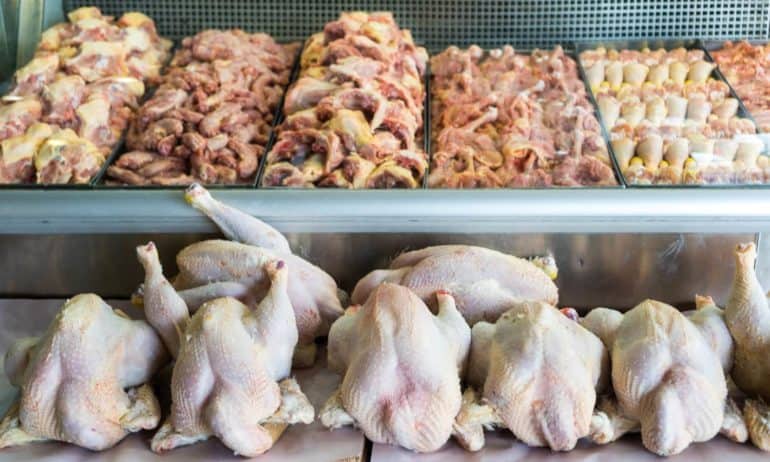In Nairobi, Kenya, one small company is making it easier for low-income families to get adequate protein in their diets via a simple innovation: selling individual pieces of chicken instead of whole birds.
Chicken Choice is a business that has been able to expand all over the city as a result of participating in the Marketplace for Nutritious Foods, one of the main supply chain intervention programs operated by the Global Alliance for Improved Nutrition (GAIN).
GAIN’s work focuses on making more nutritious foods available and affordable via supply chain solutions, and the Marketplace focuses on the link in the chain closest to consumers: the sellers.
“These guys are feeding the poor but their financing is very poor,” says Bonnie McClafferty, GAIN’s food value chain director. “They are pretty much falling through the cracks because they’re too small for all of the big lending and they’re too big for microfinance.”
McClafferty says that since most low-income mothers and families in these areas are buying their food from these kinds of small enterprises as opposed to supermarkets, helping those businesses succeed and expand is key to making more nutritious food available.
To do that, the Marketplace provides a network of community support and trainings, technical assistance, and funding to businesses that qualify. In addition to Kenya, it’s currently operating in Rwanda and previously supported businesses in Mozambique and Tanzania. According to statistics gathered by GAIN, it has produced 34 million servings of nutritious food to date.
Nutrition in Nairobi
More than 48 million people live in Kenya, and about 46 percent live below the poverty line. The population is heavily concentrated in and around the capital city of Nairobi, which is also home to Kibera, Africa’s largest urban slum.
High poverty rates mean high rates of food insecurity, and drought conditions over the past few years have exacerbated the problem. According to UNICEF, 3.4 million people were severely food insecure in 2017, with about 480,000 children requiring treatment for acute malnutrition, including more than 100,000 suffering from severe acute malnutrition.
McClafferty explains that the country’s urban poor primarily get their food from what GAIN calls small and middle size enterprises (SMEs), so helping those businesses provide more nutritious options at affordable prices makes practical sense as a way to combat the high rates of food insecurity and malnutrition.
Providing protein, especially, is key, since lack of adequate protein, or
“energy malnutrition” is the primary manifestation of malnutrition in developing countries (followed by deficiencies in micronutrients like iron and iodine).
The Chicken Solution
Chicken is high in protein, but in Kenya, explains Jillian Kanaiza Makungu, a GAIN project associate who manages the Marketplace in Kenya, it’s also very expensive when local income is taken into account, especially since it’s typically sold only as a whole bird.
While in wealthier countries buying a whole bird might be seen as a way to get a bargain since the price per pound is generally lower, coming up with the lump sum for the whole bird up front is not possible for people living below the poverty line.
“There weren’t so many solutions in terms of distributing the chicken in a more affordable way,” she says. “You either had to buy whole or not buy at all.”
But Chicken Choice is helping consumers get access to affordable portions of chicken. Founder Eric Muraguri decided to portion the chicken so that customers could buy amounts based on the amount of money they had available. He also made the business zero waste, selling all parts of the chicken, like organs and feet, at different price points.
In 2015, Chicken Choice was accepted into the Marketplace’s Innovation Accelerator as a recipient of both technical assistance and funding. “GAIN came in and decided to fund them so that they could build a bigger chicken holding and slaughtering facility and also provided them with funding to buy a cold chain truck,” Kanaiza Makungu says. The organization also helped them iron out technical issues related to things like market research and food safety.
Tracking Impact
When Chicken Choice was accepted into the Innovation Accelerator, it had nine retail outlets in Nairobi. Support from the Marketplace has since enabled it to open 10 more, all in low-income neighborhoods. According to GAIN’s statistics, the company increased sales to 156 metric tons (about 344,000 pounds) of chicken within Nairobi’s slum areas in 2017.
Chicken Choice is one example among many of the impact the close to 70 companies supported by the Marketplace have had so far. GAIN has disbursed more than three million dollars to grantees through the program to date and a new call for proposals is currently in the works in Kenya.
In addition to increasing access to protein via chicken, businesses have also increased production of affordable, healthy vegetables in Mozambique and eggs in Rwanda.
Another Kenyan business, Tarakwo Dairies, even applied a serving size innovation similar to Chicken Choice’s to milk. Instead of Kenyans having to come up with enough money to buy a gallon of milk, it created “milk ATMs,” which could dispense nutrient-dense, pasteurized milk in small amounts at a lower cost. The Marketplace funding allowed Tarakwo to increase its production capacity via new pasteurization equipment, refrigerated trucks, and more dispensing outlets.
McClafferty says that each example points to how supporting small businesses at this end of the supply chain is an effective strategy to make food more affordable for food insecure populations.
“It’s not a new idea. These kinds of engines are all over the place, but not for nutritious foods,” she says. “ It’s a model that we designed to go anywhere.”











